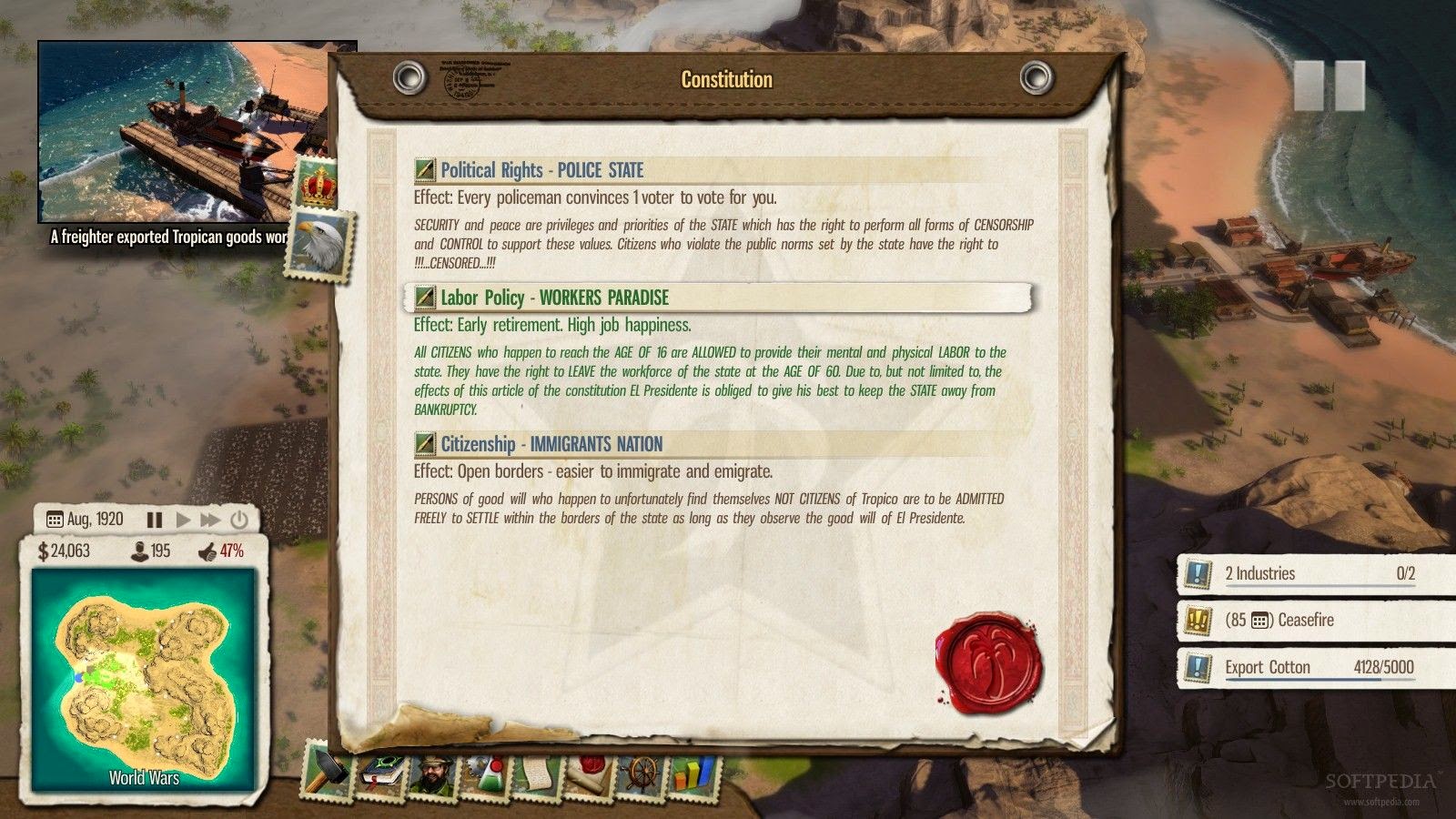It may just be the way that the development cycles of video games lay out, but a given year always seems to alternate between feast and famine when it comes to new titles. Where the first half of the year was rather dry, the second half looks to be awash under a deluge of playables. I know, I know #nerdworldproblems. If anything, these additions make for a wonderfully robust List of Excellent Distractions to help temper the anticipation for Gen Con 2014.
After binge-playing Transistor and staggering about after the gut-punch that was the ending I was profoundly grateful for the sunshine-and-salsa music filled Tropico 5. Yes, yes there will be at least one recursion of Transistor but there needs to be some time for emotional recovery first. And what better way to recover than lording over a Caribbean island or two?
 |
| Photo by Kalypso Media. |
Tropico 5 is ostensibly billed as the next installment in Kalypso Media’s beloved simulation franchise, promising a bigger, better dictatorial experience than either of its two recent predecessors. So, does it deliver on that promise? Eh, sort of. Don’t get me wrong, there’s enough new material here that makes the present incarnation seem worthwhile, but just how well said content functions will likely depend at least in part on your personal degree of familiarity with the series.
The overarching premise of Tropico 5 is the same as that of its older siblings: the player assumes the role of dictator who must manage the economy, population, and international relations of a tropical island. Your playing experience is both shaped and guided by several recurring characters who periodically appear with requests, demands, and the occasional helpful tidbit to provide structure to the simulation. Your secondary, Penultimo, also offers his distinct brand of ‘help’ as you respond to the various inquiries and build up the infrastructure of Tropico. All these interactions are shot through with a dark humor that’s surprisingly witty and devilishly fun.
Tropico 5 sought to add more structure to the actual gameplay by introducing the concept of eras. Instead of keeping the context of the game in the Cold War, as was the case with earlier incarnations of Tropico, Tropico 5 sets out during the Colonial Period with the player as the Crown-appointed Governor. As you complete various tasks and Tropico begins to stand on its own two feet, so to speak, the prospect of throwing off the colonial yoke and taking power into your own hands becomes a reality, but it’s reality that comes with its own set of consequences. You’ll continue to navigate increasingly complex circumstances as time progresses through the Depression and Cold War eras and on to modern day.
While the eras are an interesting premise, they’re uneven in terms of how well they impact the game. In the Colonial Era only a handful of buildings are available to you, severely limiting what you can build and thus how you can service your populace. For example, there is no way for you to get any sort of healthcare to the citizens of Tropico until the Clinic can be unlocked, which is more than one era into the campaign. This rigid palette of structures doesn’t, however, translate over to the expectations your constituents have of you. Using the earlier example, you’ll be told that people will demand healthcare and think poorly of you for not providing it even if there’s no way for you to address this. Conversely, this slow trickle of new features can be a boon to new players, giving them extra time to familiarize themselves with each part of the game.
On the plus side, the eras introduce a new degree of strategy. In previous Tropicos, players started each Mission on a new island and built up infrastructure almost entirely from scratch. With Tropico 5 players alternate missions between two islands and must carefully manage both space and resources on each in turn. In an era or two, the plantations that once provided valuable cash crops are now occupying prime territory in the middle of your capital city and roadways that were once efficient thoroughfares for livestock are now circuitous corrals for traffic. Being from Boston, I handily appreciated seeing the strange, borderline nonsensical shape that my cities took on after one architectural generation was hoisted atop another. This forces the player to plan for both the short and long term, which can often take a bit of getting used to.
A component of this new longitudinal managerial style is the construction of your dynasty. At least once an era Penultimo will appear with news of the results of your…ehm…extracurricular activities. You’re given the option of recognizing your offspring (and thus gaining them as a member of your family) or casting them away into the populace, since the threat of White Walkers is minimal in sunny Tropico. Those legitimate children also walk amongst your citizens and can be assigned to one of several different tasks, such as managing various facilities or leading your army. Each family member comes with a special trait, making them particularly well equipped to handle certain tasks.
Speaking of tasks, one of the most striking differences between Tropico 5 and its predecessors is the level of micromanagement required. Individual buildings require attention beyond standard maintenance. Some structures need very specific staff while others must be monitored regularly. Upgrades and modernization also require direct intercession, which can be time consuming if done individually or very expensive if completed en masse. These enhancements also aren’t truly optional either, beyond the fact that the game does not compel you to complete them. Players of any iteration of the Civilization series will quickly realize that upkeep on your military units is key to future survival but, since this is frequently completed piecemeal, there may come a point where you’ll be inadvertently fielding tanks alongside musketmen.
 |
| The tech tree will also unlock the ability to write a constitution |
Part of avoiding that scenario is another new feature, the technology tree. Buildings with an educational or scientific bent generate research points which, in turn, can be used to unlock various perks and features. The premise is nice, but the practice is somewhat clunky. Progress along the tree is strictly limited to what breakthroughs are available in a given era. There is no Civ style rushing science production to force epoch progression and, beyond a few buildings and edicts, there’s not much in terms of active investment from the player. It seems a bit like there was supposed to be more to the tech tree, but that integration was pruned away in favor of having the player concentrate their efforts on, say, hiring the right manager for a lumber mill.
The GIR and I are both fans of the series and were very excited when Kalypso announced that Tropico 5 would feature a multiplayer option. Unfortunately, it doesn’t seem as though said option was thoroughly tested, as every attempt to use the multiplayer resulted in freezes, crashes, and unrecoverable saves and this was on the few attempts where we were able to start a game at all. Hopefully this is amended in a forthcoming patch but, as it stands, this feature is a complete dud.
While the core aspect of the game will still appeal to fans of the series and simulation games in general, Tropico 5 kind of misses the mark as a whole. Various relationships, particularly that between you and your citizens, do not seem to follow any sort of discernable logic. The happiness rating could be sky-high and the economy booming, but the player may still find themselves voted out of a job in the next election cycle. Furthermore, your constituents are more mercurial than in previous Tropicos, capable of swinging 10 percentage points in a matter of months. Contingencies between raw materials, mid-level businesses, and industries are never made entirely clear and must be discovered only via trial and error. For example, livestock will only eat corn and will die off even if you have a surplus of food on the island if said surfeit contains no corn. Disasters strike frequently, even on the ‘occasional’ disaster setting, and wreck a disproportionate amount of havoc, particularly when compared to an equivalent experience in Tropico 4. Since each mission involves a significant time commitment, the fact that any of the above can completely derail your game may promote a certain level of frustration.
There’s still fun to be had with Tropico 5, but it wouldn’t be entirely surprising if many of these new features don’t make a return appearance in the eventual Tropico 6. A lot of discordant ideas ended up in the final product and it makes for some tricky gaming as a result. If you’re on the fence about picking up Tropico 5, maybe wait a few weeks for the Steam Summer Sale.
Final Grade: B-/C+
Available for PC, Xbox 360, and PS4
















